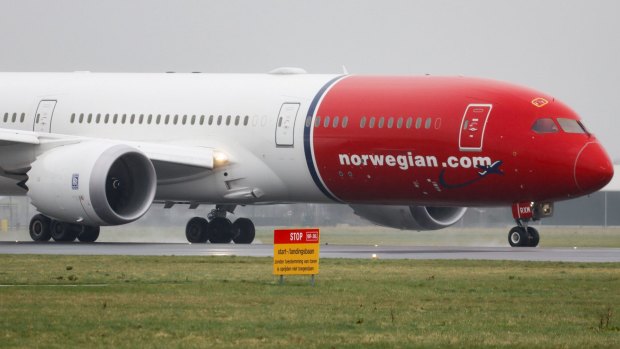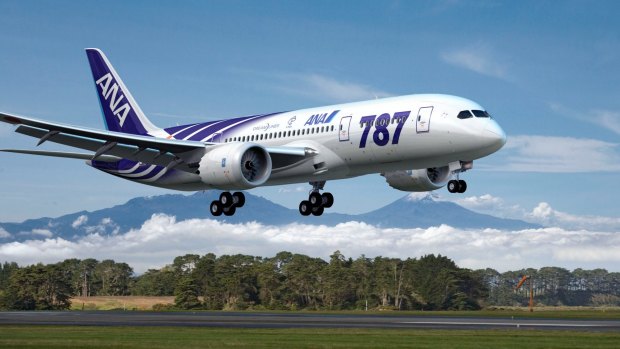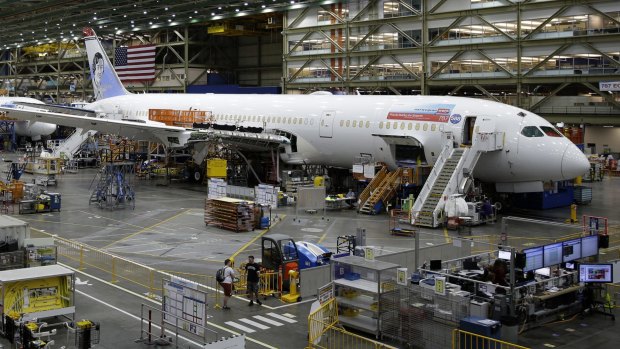This was published 1 year ago
Dreamliners are being scrapped. Are they still the future of air travel?

Two of airline Norwegian's Boeing 787 Dreamliners will be scrapped for parts.Credit: Getty Images
After less than a decade of service, two Boeing 787 Dreamliners formerly operated by budget carrier Norwegian are to be broken up, stripped down and sold off for spare parts.
These are the first commercially operated Boeing 787s to be retired, but it's no reflection on the airworthiness or commercial viability of the 787. Both aircraft have been in storage since 2019, and they're worth more for the value of their components than as passenger-carrying aircraft.
The 787 has been plagued by supply-chain issues for the past decade, and Dublin-based EirTrade Aviation, the company overseeing the dismantling operation, is expecting healthy demand for spare parts from the used serviceable material (USM) trade.

All Nippon Airways (ANA) was the launch customer for the Boeing 787 Dreamliner. The airline now has 77 of the aircraft, with a further 19 on order.Credit: BOEING
Although these are the first passenger Dreamliners to be scrapped, they are not the first Boeing 787s to be disassembled. According to a report in The Seattle Times, the fifth Boeing 787 to roll off Boeing's production line was taken apart in 2018.
The Dreamliner with registration N787FT was built in 2009, one of six 787s built for Boeing's flight test program, and only notched up 1600 hours of recorded flight time, yet that was one of the test aircraft Boeing had effectively written off due to the vast amount of work required to make them airworthy. Parts of those first test aircraft were assembled using temporary fasteners, mechanics were improvising as they worked out of sequence, awaiting the delivery of components and often having to disassemble work already completed to overcome design problems.
In mid-2016 Boeing abandoned hope of selling Dreamliners No. 4 and No. 5, writing off both aircraft as a development expense at a cost of $US1.2 billion ($A1.8 billion). Some parts of Dreamliner No. 5 were recycled, others ended up in archival displays commemorating the evolution of the Dreamliner.

A 787 Dreamliner under construction for Norwegian at Boeing's assembly plant in Everett, US, in 2017.Credit: AP
The 787 has been a game changer. This was the first commercial aircraft to make extensive use of carbon fibre reinforced polymer, allowing the hull to better withstand the pressures of expansion and contraction caused by operating between sea level and high altitude. This means a longer-lasting airframe and also one that can tolerate higher pressure inside the cabin, giving passengers more oxygen to breathe and a more comfortable ride.
The 787 also has the largest windows of any commercial aircraft, although some passengers prefer pull-down shades to the Dreamliner's electrically dimmable windows, which can be controlled by cabin crew. Another innovation, the aircraft supplies non-bleed air to the cabin, which avoids the problem of aerotoxicity, caused when lubricating oil seeps through engine seals, contaminating the air supply. The Boeing 787 is known to be the most fuel-efficient aircraft in the skies, outpacing its nearest competitor, the Airbus A350. In over a decade of service, the 787 has recorded zero fatalities and no hull losses.
Does the 787 have a bright future?
Ten years of service is not a particularly long life for a passenger jet. The average operational life expectancy of a Boeing or Airbus aircraft is around 30 years. The first Boeing 747 aircraft to make a commercial flight was not scrapped until 1992, 22 years after its first flight with Pan Am.
Despite the two decade-old Dreamliners sitting in the knacker's yard, there are no signs that this is going to be a short lived aircraft, unlike the Airbus A380, and there's no slackening in demand for Boeing's widebody.
Since the first commercial flight in 2011, Boeing has delivered more than 1600 of its 787s, and that includes a 15-month halt in production when the US Federal Aviation Administration temporarily stopped certification of newly built Boeing 787s due to multiple concerns over production issues. Production resumed in August 2022 and the company is currently sitting on 575 unfilled orders.
Some 40 airlines are flying the Dreamliner, with Japan's airlines showing the greatest appetite for the twin-aisle aircraft. The country's ANA was the launch customer, acquiring the first three built after the flight test fleet. Today the airline operates 77 Dreamliners, with another 19 on order. Japan Airlines has 51 with no further orders. American Airlines and United are also major buyers, with 55 and 69 respectively, and United has over 100 still to be delivered. Qantas has 22 with three more on order.
For airlines looking for aircraft capable of carrying more than 300 passengers and operating long-haul routes, Boeing's 787 and the Airbus A350 are the default choice. The fact that two 787s have ended up in the wrecker's yard is not going to dent airlines' confidence.
See also: Not dead yet: The airlines still flying 747 jumbo jets
See also: What happens when a plane gets scrapped
Sign up for the Traveller newsletter
The latest travel news, tips and inspiration delivered to your inbox. Sign up now.